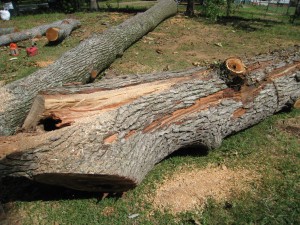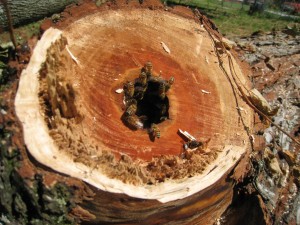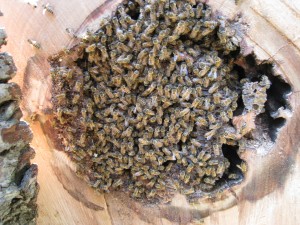Today has been something else. We had a family crisis over the weekend and it has turned to the better as of this afternoon. With a few hours of time to relax, I decided to tackle some of my high priority items.
- The Blue Cottage Hive needs some capped brood to bolster its weak ranks
- The Southside Hive needs some eggs, in case I didn’t get the queen when I extracted the hive
So, I decided I would take both frames from the same hive. The first hive that I checked was the Geronimo Hive. Very gentle bees and (so far) the strongest of Tom Fifer’s strain that I have received. They didn’t give me honey this year, but they are the best hive I have. Interestingly enough, extracting that hive from the fallen tree over the weekend really relaxed me about the bees. I had bees all over me for hours and kept on working. So, when I went to the Geronimo Hive, I didn’t even think about the smoke. I also never wavered as they flew about. But, they gave me a big surprise.
I pulled up the t-cover and bees literally spilled out of the hole in the inner cover. It was like a small volcano! Only a few took flight – the rest just spilled out, rolling all over the top. This was odd. I had only expected to give a brief look at what had to be an empty honey (Illinois) super and then was going to look for my swap frames in the top brood chamber. So, I popped the inner cover and gave her a better look. Low and behold, these rascals were drawing that thing out and storing nectar/honey! All Spring, I have fretted about not getting any honey and only recently resigned myself to this fact and decided that I would instead look forward to doing a couple of splits. So, what happens? The bees go ahead and start working on the daggone honey! Ha! I look forward to A for so long and finally become depressed that I will not get A. I look at the bright side and start to look forward to B, giving up on A. Once I get really excited about B, those women go ahead and give me A! Wow.
At any rate, regardless of my emotional trauma, I took the honey super off and gave a brief look at a couple of frames in the top Brood chamber. Typical brood pattern with honey and pollen storage. Five zillion bees wishing I would go away. Lots of good news. I was not going to take eggs and brood from a hive that might give me honey (at least no this year!) So, I put them back together and let ’em be.
Geronimo Hive
Queen : No sign
Eggs: Too dark to see. Did see larvae.
Only checked the Medium (drawing out all 10 frames, some nearly finished) and the top Brood chamber (lots of capped brood, honey and pollen.) Installed an Imri Shim to see how that might help them (the State Apiarist said studies show that it does increase the honey crop.)
Hive temperament was very relaxed (and possibly annoyed)
So, on to round 2. I pulled open the Albo Hive and bees also spilled out of it. I didn’t even take off the inner cover. I will inspect them later this week. The similar appearance (and the fact that the Imri Shim for these gals was installed a week or two ago) was all that I needed. No stealing brood/eggs from these gals either. I might get a bit of honey from them too!
At this point, I was torn. I couldn’t figure out which hive, Albo or Geronimo, to go for. Then it struck me – the Westover Hive! Very strong hive. Built up quickly. A tad cranky, but not that bad. I was thinking about splitting them anyway, to expand the bloodline. This was the perfect choice.
So, I opened these gals up and found just what I was looking for. They were working 8 of the 10 frames up top and had not touched (except with their legs, as they scurried over the foundation) the honey super. I would have been surprised if they had. They were at pretty much the same spot they were last time, so this pretty much proves to me the value of feeding a new swarm. I might feed them more when I receive a few more top feeders to help them fill out the remainder of that top brood chamber.
The second drawn frame had a ton of eggs and a good rim of honey. This was perfect for the Southside Hive, which I am going to get a feeder on tonight anyway. The third frame was a ton of capped brood, with the same honey stores. I took out the brush and irritated the badoodle out of them as I brushed them off, but was able to get every last bee off before putting into a transport Nuc and moving to either hive. I checked several more frames and found a good pattern with stores. No sign of swarming (at least in the upper brood chamber.) I was happy with the results and put them back together.
Westover Hive
Queen: No sign, but found eggs, that I gave to the Southside Hive in case they need to start a Queen.
Working 8 of 10 frames in the upper brood chamber, but I took 2, so they are down to 6. I alternated empty foundation between drawn comb with the two new additions and closed them back up.
On opening the Blue Cottage Hive, I was sad to see several small hive beetles. I see them in the hives on occasion, but this small hive might not be able to handle them. I will make a few traps this week and get them on next weekend, to help them out a bit. I also spotted that wiley queen, with a big blue dot on her back. It’s not as noticeable as I had expected, as the ‘blue’ is a really dark blue. But, I spotted her and was happy. Also found a few eggs, but they need more bees (and comb.) I dropped the new comb with capped brood in to give them a new workforce over the coming couple of weeks. Once I get some honey off of one of the other hives, I will give them another dose (probably late June or early July) of capped brood. The primary goal now is to get a bottle feeder on them and give them something to fight the small hive beetle. More on that later.
Blue Cottage Hive
Queen: found her on the last frame. Spotted eggs too.
Frames : Now working 3 frames. 50% growth is not bad, but the third frame only had a bit on it. Gave them a full new frame that should help, if the small hive beetles don’t do too much damage first. So, now they have 4 frames.
Southside Hive
I did not do a good job of counting exactly what I have here yet. I think it is about 6 frames of brood comb from the tree and 4 drawn foundation. I replaced one of the drawn foundation frames with a frame of eggs (and a bit of capped brood and larvae). I’ll be working to get rid of the frames with their brood comb, as I am not sure what those fellows sprayed down in the hole and if it got on any of the stuff. But, first I want to see them get started (evidence of a queen is what I need.)
Tonight, when the sun goes down, I will move them and put a feeder on them (well, I might put a feeder on them tomorrow.) I put them under the shed in haste, due to the family emergency coming up right when I got home with them. They can’t stay there (or I can’t move my lawn mower!) I will disrupt them one last time tonight and put a limb in front of their entrance so that they will hopefully reorient tomorrow morning and start a good bit of growth.



